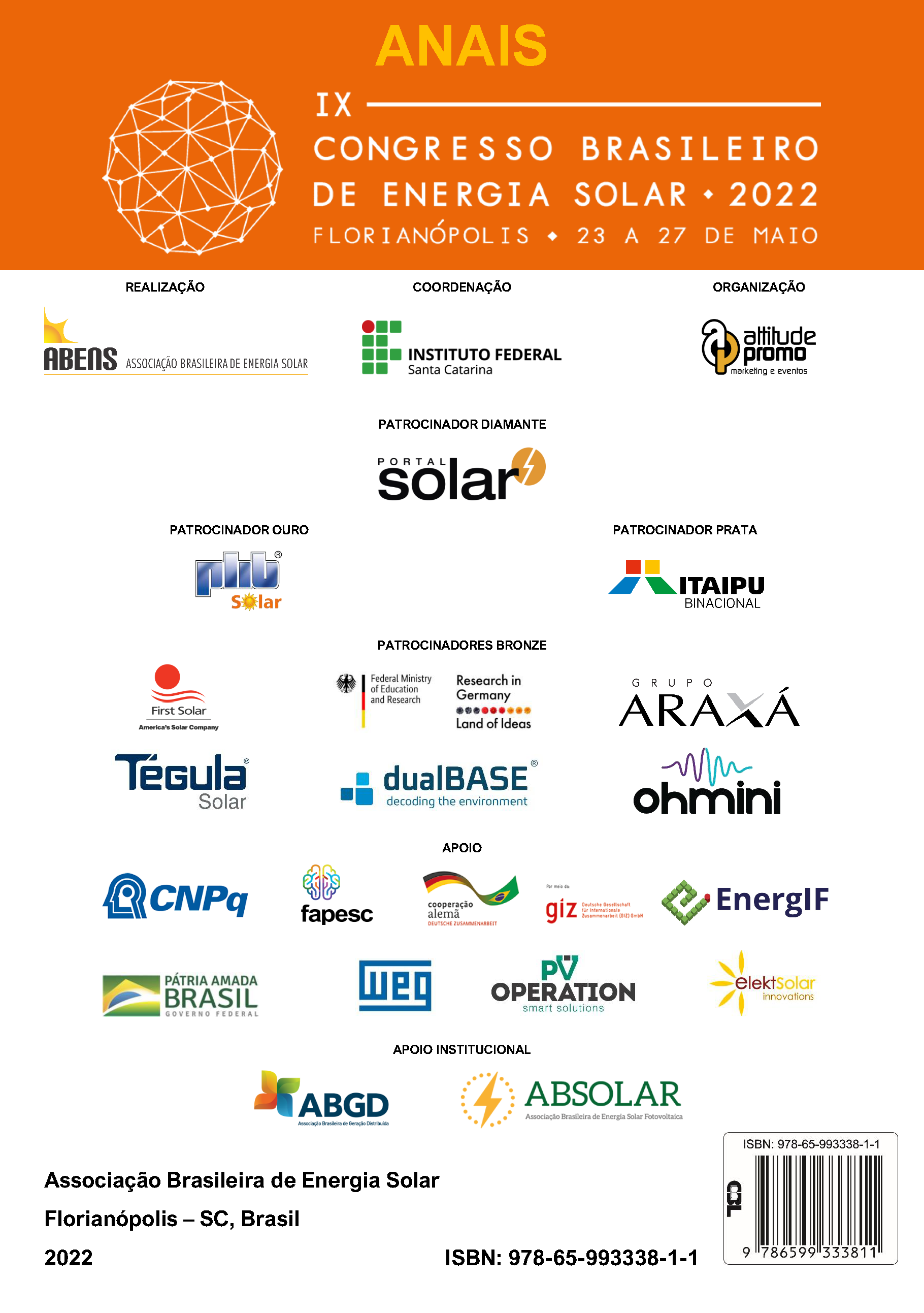PERFORMANCE ANALYSIS OF A PHOTOVOLTAIC SYSTEM WITH SINGLE-AXIS TRACKING
DOI:
https://doi.org/10.59627/cbens.2022.1187Keywords:
Performance, Solar Tracker, Solar EnergyAbstract
Abstract. Currently, solar trackers have been a constant presence in medium and large photovoltaic (PV) plants due to the increase in the capacity factor provided by their use, which also leads to a rise in the economic viability of PV projects in general. Studies show that tracked systems have a Lower Levelized Cost of Energy (LCOE) than fixed systems. Thus, of the several types of trackers, the most used in the market have been the horizontal single-axis ones with rotation axis in the North-South (N-S) direction for having precisely lower LCOE. In this context, the work proposed here aims, from simulations, to analyze how the design parameters of a 7.04 kWp photovoltaic system with 1-axis N-S tracking can affect the energy performance metrics. The design parameters analyzed will be the use of tracking compared to a fixed system, the tracker aperture angle (angular variation corresponding to the tracking motion), the distance between module rows, and the use of backtracking. The analysis will consider the values of the AC energy (ECA) injected into the grid, the final yield (YF), and the capacity factor as metrics used to compare the energy performance between photovoltaic systems with different technologies. In annual terms, the energy increase is 18% compared to a fixed system tilted at 10° facing north. The YF increases up to an opening angle of 110°, while the inter-row distance of 10 m showed higher ECA. Finally, found the use of backtracking has no significant benefits.
Downloads
References
Afanasyeva, S., Bogdanov, D., Breyer, C., 2018. Relevance of PV with single-axis tracking for energy scenarios. Solar Energy, v. 173, p. 173-191.
Bahrami, A., Okoye, C. O., 2018. The performance and ranking pattern of PV systems incorporated with solar trackers in the northern hemisphere. Renewable and Sustainable Energy Reviews, v. 97, p. 138-151.
EPE, 2018. Projetos Fotovoltaicos nos leilões de energia- características dos empreendimentos participantes nos leilões de 2013 a 2018. Empresa de Pesquisa Energética. Disponível em <https://www.epe.gov.br/sites-pt/publicacoes- dados-abertos/publicacoes/publicacoesarquivos/publicacao-110/topico-418/epe-dee-nt-091_2018-r0.pdf >. Acesso em nov/2021.
Erbs, D. G., Klein, S. A., Duffie, J. A., 1982. Estimation of the diffuse radiation fraction for hourly, daily and monthly- average global radiation. Solar Energy, v. 28, n. 4, p. 293–302.
Fraidenraich, N., Barbosa, E., 1999. Experimental performance of a PV V-trough system. Proceedings of ISES 1999 Solar World Congress, Jerusalem, Israel.
Gilman, P., 2015). SAM photovoltaic model technical reference. National Renewable Energy Lab. (NREL), Golden, CO, United States.
Hay, J. E.; Davies, J. A., 1980. Calculation of the Solar Radiation Incident on an Inclined Surface, p. 59-72. Proceedings of the First Canadian Solar Radiation Data Workshop. Ministry of Supply and Services, Toronto.
Hofmann, M., Seckmeyer, G., 2017. A new model for estimating the diffuse fraction of solar irradiance for photovoltaic system simulations. Energies, v. 10, n. 2, p. 248.
International Electrotechnical Commission, 1998. Photovoltaic system performance monitoring – Guidelines for measurement, data exchange and analysis. IEC 61724:1998.
Ineichen, P., Perez, R. R., Seal, R. D., Maxwell, E. L., Zalenka, A. J. A. T., 1992. Dynamic global-to-direct irradiance conversion models. ASHRAE transactions, v. 98, n. 1, p. 354-369.
Klucher, T. M., 1979. Evaluation of models to predict insolation on tilted surfaces. Solar Energy, v. 23, n. 2, p. 111–114. Liu, B. Y. H., Jordan, R. C., 1962. Daily insolation on surfaces tilted toward the equator. ASRHAE J., v. 3, n. 10, p. 53. Orgill, J. F., Hollands, K. G. T., 1976. Correlation equation for hourly diffuse radiation on a horizontal surface. Solar
Energy, v. 19, n. 4, p. 357–359.
Perez, R., Ineichen, P., Seals, R., Michalsky, J., Stewart, R., 1990.. Modeling daylight availability and irradiance components from direct and global irradiance. Solar Energy, v. 44, n. 5, p. 271-289.
PVsyst, 2021a. Disponível em: <https://www.pvsyst.com/>. Acesso em 06 dez. 2021.
PVsyst, 2021b. Backtracking performance compared with no backtracking. Disponível em:
<https://www.pvsyst.com/help/backtracking_performance.htm>. Acesso em 14 dez. 2021.
PV*SOL, 2021. Disponível em: <https://valentin-software.com/en/products/pvsol-premium/>. Acesso em 06 dez. 2021. Reise, C., Müller, B., Moser, D., Belluardo, G., Ingenhoven, P., 2018. Uncertainties in PV System Yield Predictions and
Assessments. IEA-PVPS, Report IEA-PVPS T13-12.
Rabl, A.; Oxford, N. Y. Active Solar Collectors and Their Applications. 1. ed. New York: Oxford University Press, Inc, 1985.
Reindl, D. T., Beckman, W. A.; Duffie, J. A., 1990. Evaluation of Hourly Tilted Surface Radiation Models. Solar Energy, v. 45, n. 1, p. 9–17.
Rodríguez-Gallegos, C. D., Liu, H., Gandhi, O., Singh, J. P., Krishnamurthy, V., Kumar, A., Stein, J. S., Wang, S., Li, L., Reindl, T., Peters, I. M., 2020. Global techno-economic performance of bifacial and tracking photovoltaic systems. Joule, v. 4, n. 7, p. 1514-1541.
Sá Campos, M. H., Tiba, C., 2021. npTrack: A n-Position Single Axis Solar Tracker Model for Optimized Energy Collection. Energies, v. 14, n. 4, p. 925.
Silva, M., Castro, R., Batalha, M., 2020. Technical and Economic Optimal Solutions for Utility-Scale Solar Photovoltaic Parks. Electronics, v. 9, n. 3, p. 400.
Vilela, O. C., Fraidenraich, N., Tiba, C., 2003. Photovoltaic pumping systems driven by tracking collectors. Experiments and simulation. Solar Energy, v. 74, n. 1, p. 45-52.


